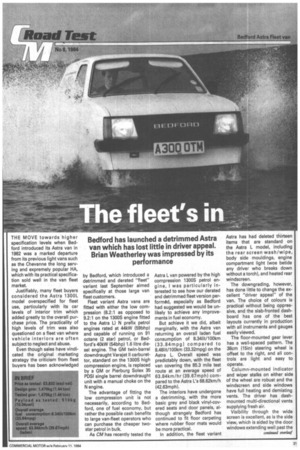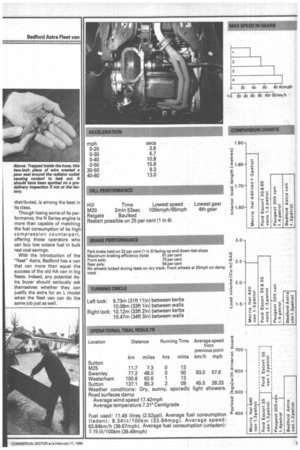Bedford has launched a detrimmed Astra van which has lost
Page 33

Page 34

Page 35

If you've noticed an error in this article please click here to report it so we can fix it.
little in driver appeal. Brian Weatherley was impressed by its performance
THE MOVE towards higher specification levels when Bedford introduced its Astra van in 1982 was a marked departure from its previous light vans such as the Cheyenne the long serving and expremely popular HA, which with its practical specification sold well in the van fleet market.
Justifiably, many fleet buyers considered the Astra 1300L model overspecified for fleet use, particularly with its car levels of interior trim which added greatly to the overall purchase price. The practicality of high levels of trim was also questioned on a fleet van where vehicle interiors are often subject to neglect and abuse.
Even though sales have vindicated the original marketing strategy the criticism from fleet buyers has been acknowledged by Bedford, which introduced a detrimmed and derated "fleet" variant last September aimed specifically at those large van fleet customers.
Fleet variant Astra vans are fitted with either the low compression (8.2:1 as opposed to 9.2:1 on the 1300S engine fitted to the Astra L) N prefix petrol engines rated at 44kW (59bhp) and capable of running on 91 octane (2 star) petrol, or Bedford's 40kW (54bhp) 1.6 litre diesel engine. The GM twin-barrel downdraught Varajet II carburettor, standard on the 1300S high compression engine, is replaced by a GM or Pierburg Solex 35 POSI single barrel downdraught unit with a manual choke on the N engine.
The advantage of fitting the low compression unit is not necessarily, according to Bedford, one of fuel economy, but rather the possible cash benefits to large van-fleet operators who can purchase the cheaper twostar petrol in bulk.
As CM has recently tested the Astra L van powered by the high compression 1300S petrol engine, I was particularly interested to see how our derated and detrimmed fleet version performed, especially as Bedford had suggested we would be unlikely to achieve any improvements in fuel economy.
But achieve it we did, albeit marginally, with the Astra van returning an overall laden fuel consumption of 8.341it/100km (3 3.8 4mpg) compared to 8.48Iit/100km (33.32mpg) on the Astra L. Overall speed was predictably down, with the fleet van covering the 85.3 mile test route at an average speed of 63.84km/hr (39.67mph) compared to the Astra L's 68.62km/h (42.63mph).
The interiors have undergone a detrimming, with the more basic grey and black vinyl-covered seats and door panels, although strangely Bedford has continued to fit floor carpeting where rubber floor mats would be more practical.
In addition, the fleet variant Astra has had deleted thirteen items that are standard on the Astra L model, including the rear screen wash/wipe, body side mouldings, engine compartment light (woe betide any driver who breaks down without a torch), and heated rear windscreen.
The downgrading, however, has done little to change the excellent "driver appeal" of the van. The choice of colours is practical without being oppressive, and the slab-fronted dashboard has one of the best layouts currently in production with all instruments and gauges easily viewed.
The floor-mounted gear lever has a well-spaced pattern. The 38cm (15in) steering wheel is offset to the right, and all controls are light and easy to operate.
Column-mounted indicator and wiper stalks on either side of the wheel are robust and the windscreen and side windows have full heating and demisting vents. The driver has dashmounted multi-directional vents supplying fresh air.
Visibility through the wide screen is excellent, as is the side view, which is aided by the door windows extending well past the driving position. The lack of rearscreen demister and wash/wipe does little to help rear visibility particularly on wet days, and 1 would question its removal even on a fleet vehicle, although the Astra Fleet van is supplied with two useful wing mirrors as standard.
When Bedford launched the Fleet Astra it also increased the gross vehicle weights on all 1300 Astra vans by adding higher capacity spindles, 165SR radial tyres and heavier duty struts to give a revised gvw of 1470kg (1.44tons).
Even so, with the long body and rear axle overhang it soon became apparent that a great deal of care has to be taken not to overload the rear axle. According to Bedford, a uniform load using the whole van body can be achieved, but only with a payload up to 415kg (8.17cwt) — some 95 kgs (209 lb) short of the van's gvw with the driver on board. However, it is unlikely that the average van operator will use the vehicle anywhere close to its maximum gross vehicle weight.
Sliding the test weights into the vehicle was made easier by the low platform height of 0.5m(22in) and the raised ribs in the floor. The level of finish in the cargo area, though generally good, is spoilt by the poor attention to joining between the floor pan and wheelarches.
The interior is lined with wooden battens, which help to prevent panel damage in the 1.75m(69in) length load platform (the Ford Escort van has a shorter load length of 1.64m(65in). The sloping rear of the tailgate, however, reduced the practical load space, particularly if carrying boxes or cartons.
The low, 1.37m (54in), roof height is a further temptation to the lazy driver to load only as far as he can reach, for the only way to load right up to the cargo barrier is to climb into the back of the van body.
Although the Astra fleet van has lost some 11kW(14.7bhp) with the fitting of the derated engine, any driver used to the 1300S Astra L would be hard pressed to spot the initial difference in performance between his own and the N-engined fleet van.
Our test vehicle showed plenty of pace in busy traffic. On the motorway it held 70mph easily and quietly.
The reduction in specification, has meant that the fleet van cannot be ordered with the fivespeed gearbox option, although it is possible to specify a low compression N series engine with a five-speed or automatic gearbox on an Astra L model van, thus retaining its high level of trim.
The fleet variant's acceleration figures recorded at Mira were not far behind its high compression counterpart, with the vehicle returning a 0-50mph time of 15.6 seconds compared to the 11.5 figure from the Astra L powered by the 1300S engine but running at the slightly lower gvw of 1,420 kg (1.40 tons). There was a noticeable flat spot, however, when accelerating from 40-50mph in top gear. Whether driving around our test route or on the Mira circuit, the fleet van exhibited good handling characteristics, with only a slight hint of oversteer when accelerating out of tight bends. The seat, though generally comfortable, needed more support in the base.
Results from the brake tester showed all wheels to be braking evenly, although testing on the rear wheels suggested a pos sible fault in the load-sensitive apportioning valve. The rear brakes returned figures of 300400lb braking force, which slowly rose to 4501b only after prolonged pedal pressure.
During brake tests at Mira the van pulled up quickly and straight with the front whe3ls locking. The full brake stop did, however, highlight the deficiency in the load restraint barrier.
Having a curved cross section to allow the seats to tilt back to the maximum, contact with heavy high sided boxes is only made along the top edge. With only cross members to support it, any sudden transfer of load against the top of the 40cm (Thin) high barrier caused it to buckle and move forward into contact with the back of the seat. A more sensible solution would be to sacrifice some of the load platform length in the Astra and fit a full-height vertical mesh barrier anchored at the base, roof and body sides.
Another part of the Astra van likely to get more than its fair share of hard knocks is the large, metal, air-dam/front panel mounted below the front bumper. Although some 23cm(19in) off the ground at its lowest point, the spoiler can be easily damaged by careless parking over high kerbs. The metal skirt is also prone to stone damage with the resulting risk of premature body corrosion. A grp front dam would be a more practical fitment.
Underneath the bonnet the Astra van is well laid out, with most daily checks easily accomplished, although the screen wash bottle is too small for a light van in constant use. The spare wheel is mounted in a compartment in the load floor.
At £3,832 (£216 cheaper than a 1300S petrol engined Astra L), the 1.3 low compression engined Astra van is in line with similar basic trimmed light vans such as the Morris Ital 440 (£3,694) and the Ford Escort Popular van (£3,717) although the latter is only available with a 1.1 litre engine. Standard Escort 35 vans equipped with 1.3 engines have trim levels similar to the Astra L (all prices exclude vat).
Summary Detrimmed and derated, the Astra van has lost little of its overall driver appeal. The vinyl interior is practical without being spartan. The estate carbased body offers a good load volume, its payload, if carefully
distributed, is among the best in its class.
Though losing some of its performance, the N Series engine is more than capable of matching the fuel consumption of its high compression counterpart, offering those operators who can buy low octane fuel in bulk real cost savings.
With the introduction of the "fleet" Astra, Bedford has a van that can more than equal the success of the old HA van in big fleets. Indeed, any potential Astra buyer should seriously ask themselves whether they can justify the extra for an L model when the fleet van can do the same job just as well.
















































































